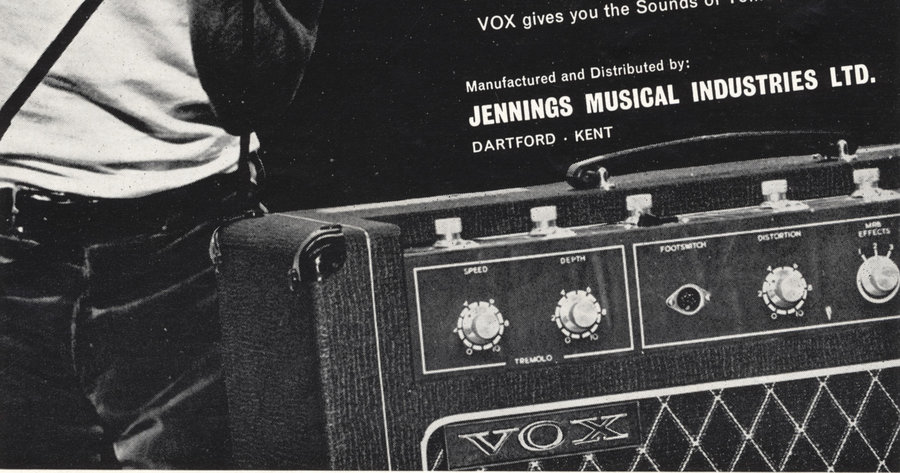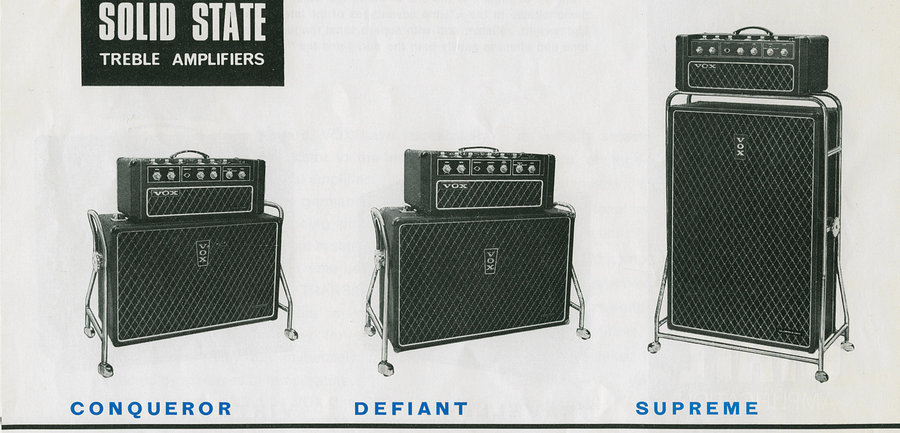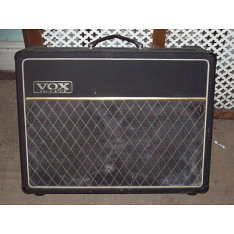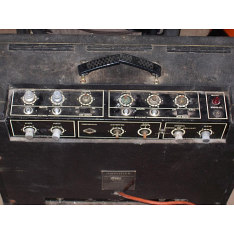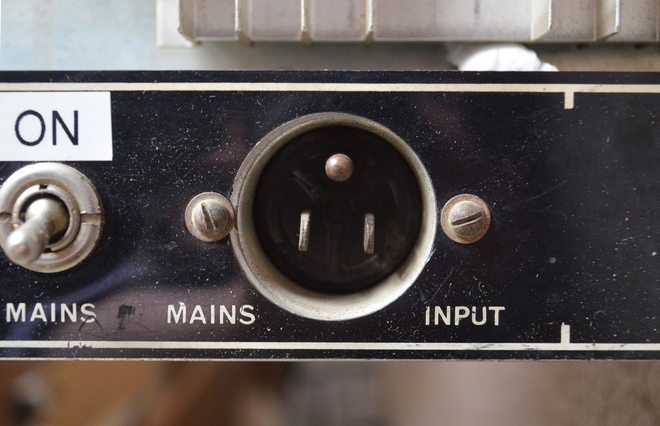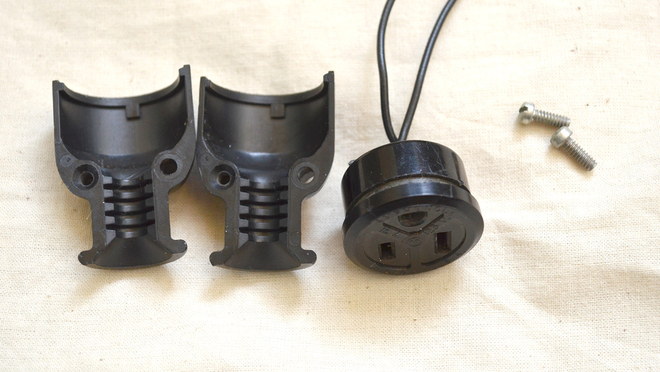PRE-PRODUCTION SOLID STATE AMPS
Jennings Musical Industries: mid 1966 - April 1967
Early summer 1966. From a set of the earliest pictures currently known of the solid state range. Perhaps a Defiant or Supreme amplifier section. The control panel is a printed overlay at this stage - one can see the wrinkles.
The control panel of a surviving pre-production Defiant.
This page was originally entitled "prototypes", but it quickly became clear that the amps illustrated below - mainly produced by Burndept Electronics for Vox in early 1967 - were "pre-production" units. "Prototype" suggests work-in-progress - something of a scrappy nature. The amps on this page are finished enough to use.
Quite how many were produced is unknown at present - treble models (for guitar) came first, followed by bass. At least one set is likely to have been made for promotional and demonstration purposes, some perhaps being sent to key music shops (Hessy's in Liverpool, for example) for local musicians to try. Others were given direct to select bands - Manfred Mann (see the foot of this page) and Blossom Toes being two known examples.
On the strength of comments and feedback, Vox made substantial changes. The standard production amps that came to market in March 1967 took a visibly (and electronically) different form. The intention to issue the range in its pre-production form - and this was clearly the initial intention (see for instance the illustrations in adverts) - had to be dropped.
Above, sold on ebay in 2012, a handbill, 7 7/8" X 4 7/8". It seems likely that such shows were arranged in early 1967 primarily to advertise the new solid state range - at this date, the pre-production amps. In other words these formed part of the testing process that culminated in the redesign of the control panels among other things.
That JMI adverts continued to show pre-production units well into 1967 indicates perhaps that no small effort had been invested in the initial designs:
"Beat Instrumental" magazine, October 1966, showing part of a pre-production solid state amplifier. Further adverts can be found on this page. Note the distinctive scratch to the right of the distortion control. The same amp appears in other ads.
The catalogue issued in the UK in April 1967 - available in full here. All the amps illustrated are in their pre-production form with DIN socket over to the left and indicator lamps on top of the control panel instead of the front. See further below.
Illustrations of pre-production amps also figure in the brochure produced for the Australian market in late 1966, and in the catalogue produced in conjunction with the Frankfurt Music Fair in late February 1967 - see the updates page, entry for 7th August.
Background
Key to the whole process was the visit Dick Denney paid to the States in late October / early November 1965 to advise on, and hear the new line of solid state amps then being designed by the Thomas Organ Company ("Vox USA"). The details are documented in the "Vox Story", ed. D. Denney and D. Petersen (1993), appendix 3, pp. 141-145 - still a mine of reliable info. Of particular interest is the way in which Denney took up and applied some of the ideas that had been worked out in America - first to the hybrid 7-series amps (1966) with transistorised preamps but valve power amps (transistors for power amps were still unstable and unreliable at the time); and a year later to the fully solid state range - the Conqueror, Defiant and Supreme, et al.
Chief among the innovations adopted was "modularisation". The UL715, 730, 760 and 7120 had identical preamps, as did, on the bass side, the UL430, 460 and 4120. The 730 and 430; 460 and 760; 4120 and 7120 had power sections in common.
The fully solid state line followed suit. The Conqueror (30W), Defiant (50W) and Supreme (100W) had identical preamps, as did the Dynamic Bass (30W), Foundation Bass (50W) and Super Foundation (100W). The Conqueror and Dynamic; Defiant and Foundation; and Supreme and Super Foundation had common power sections. It is worth noting too that the Conqueror and Dynamic Bass had smaller wooden boxes.
On a more detailed level, some of the circuitry first adopted in the Thomas Organ amps was taken up too - the best-known instance perhaps being the the mid-range (resonant) boost that Denney had seen and heard on the engineering prototype of the Super Beatle. For further details on this effect, see this page.
Below, the promotional shot of a Supreme illustrated by Denney and Petersen and described as being "perhaps the handsomest amplifier ever made". The amp was evidently a pre-production unit. It is also seen in the Mick Jagger advert above (from October 1966 - see the "Beat Instrumental" history page for other ads and flyers, and their dates).
Note that scratch by the distortion control on the fascia. The DIN socket for the footswitch is over to the left and mounted longitudinally; the indicator lamps are on top of the control panel. It may have been this amp that stood also as the Defiant in other promotional pictures - Defiants and Supremes look identical from the front. Note that there is no flag giving the name of the model.
An early standard production Supreme. The Stones had the first standard production amps, seen in late March '67.
On the front fascia of the pre-production control panel, the order of controls, left to right, is: Tremolo Speed and Depth; Footswitch; Distortion; MRB Effects: Reverb Channel and Blend. The indicator lamps are on top of the panel, rather than on the front.
On standard production models the order is: Tremolo Speed and Depth; Reverb Channel and Blend; MRB Effects; Footswitch; Distortion. The indicator lamps are front-facing.
PRE-PRODUCTION AMPS
STAGE 1
The Vox Conqueror shown at the "British Musical Instrument Industries" fair at the Russell Hotel, 21st to 25th August 1966. Picture from "Beat Instrumental" magazine, October 1966. Outsize footswitch, feeding into two DIN sockets on the preamp fascia. Lights on top of the control panel - hard to tell from the picture, but there may be only one. The amp looks, to all intents and purposes, finished - ie. ready for general production. To its left (our right) the upright of a tall Vox trolley is visible - either an AC100 or early Supreme? For Vox promotion material on the solid state line, see this page - mainly Beat Instrumental magazine.
Note that the general design of the amp is finished. Prototyping is likely to have begun in 1966. The footswitch was offered as an option in the pre-production brochure printed for the Australian market in late 1966 - see this page.
STAGE 2
In the second amp along on the shelf in the image above (a Defiant or Supreme), there seem to be no vents in the box and only one light on top panel. As on the amp below, some of the aluminium knobs are tall, others of smaller (production) size.
STAGE 2a
Defiant. The box has four vents - two long, two short. Only a single lamp on top, the other blanked off (as in the amp above). Inputs are numbered "1" and "2". The amp retains its original Amphenol 160-5N power socket. The RCA 2N3442 power transistors have the date code "6G" = July 1966.
Probably from this stage too, a combo with features of what were to become on the one hand the Vox Traveller and on the other the Vox Virtuoso, 2 x 10" speaker format. Clearly at this point the Virtuoso and Traveller did not exist as separate amps:
A Traveller / Virtuoso combo that came to light in late 2017. Steve Walsh, who found this amp, noted: "the tone stacks on both channels are identical to the Mk1 SS amps. The tremolo board seems to be almost identical to the USA version. The reverb board is identical to the UK SS ones. The distortion is unlike anything I've seen in either US or UK amps. That said, it sounds great. It's permanently on in this amp unless switched off via footswitch."
Below, an amp that came to light in the late 2000s:
All sorts of things are different in the "lights-on-top-panel" circuit - from the position of items, to the form of the items themselves - for instance, the inductor in the MRB circuit. Note that in all amps on this page, the main transformer is central on the power section chassis. The position in standard production models is at the end.
Above, the standard preamp layout of an early Conqueror.
The Bass Amplifiers
STAGE 3
To date (Sept. 2014), only bass amps have come to light with the footswitch socket termed a "Remote Socket". Inputs are no longer numbered. Indicator lamps are on the front of the control panel, not the top.
Dynamic Bass
Note the two vents on the top = Dynamic Bass. The inspection tag shows that this amp was assembled by Burndept Electronics, contractors for Vox in Erith. The same is doubtless true for the amp below.
Another Dynamic Bass - currently in France
As above, the footswitch socket over to left and entitled "Remote Socket". The piece of metal on the front panel over the place where the footswitch is normally to be found on production amps is probably masks later work. In the bass channel, both controls are captioned "Volume". The American-style Edison mains socket (see the Defiant above for an original) has been replaced with a standard IEC inlet.
Foundation Bass
All stencilled legends as in the amps above and below. The footswitch socket is sideways and titled "Remote Socket"; and the knobs have tall waists. These are the type of knobs used on Vox effects units. Thanks to Ihor for the pictures.
Super Foundation Bass
Images from this great thread.
COMPARISONS - click as ever for larger images
AN EARLY SIGHTING OF A PRE-STANDARD-PRODUCTION SUPREME
From pictures taken in late 1967 and c. 1970, below, it is evident that at least one early Supreme found its way into the hands of a well-known musician:
Manfred Mann in Berlin with his pre-production Supreme, 1967. Observe where the speaker and mains cables plug in - speaker far left, mains far right. On standard production amps the mains socket is close to the middle, and the speaker socket far right.
Manfred Mann in concert - in the first picture, note to his left a Vox UL4120 / 7120 cab on its side. In the foreground of the second, part of the control panel of the Supreme. In the third, one can just see the fascia of the panel. The footswitch socket is mounted "sideways", as in the pre-production amp shown in the advert - there are visibly two controls to its right, and one can see the white lines marking out a panel to the right of that. In the middle picture, one can see that the inputs are numbered "1" and "2".
The combination of Supreme amp and 4120/7120 cab seems to have been particularly popular early on. At least three other sets (standard production models) are known to have been issued to bands in 1967: Los Bravos, Los Brincos and the Zombies. Such sets evidently appealed to, or were indeed aimed at, keyboardists. Further pictures will be posted on a page devoted to bands with Supremes.
PROCESS
The principal question posed by these amps is not so much what they were for - they clearly belong to official pre-production runs set in motion for promotional, testing, and demonstration purposes - but how they come to survive.
The answer is relatively straightforward. When consigned to bands, they were used for a time and then passed on. When sent to music shops, they were either put in the back room once their demonstation duties were over and sold at some later juncture; or perhaps simply sold (probably as second hand) when batches of standard production amps arrived.
That they looked and sounded a bit different from the new arrivals was probably of no account to the new owner.
As for the changes inherent in standard production amps, one can easily see why the position of the indicator lamps was changed - on the Conqueror and Defiant, lamps on top would be fine; on the Supreme, however, certainly not, especially in the case of a musician of less than average stature.
Changes in the electronics probably stemmed both from work that went on in the interim - ie. between Jan. and March 1967 - at Burndept Electronics (the contractors), and from the practicalities involved in the setting up of the component supply and assembly lines.
NOTES ON COMPONENTS
Above, the power socket on a pre-production Defiant currently in the UK. Modern (and 1970s) US connectors look as though they should fit, but are unfortunately 1/4" too large. Suitable original connectors are extremely difficult to find these days.
Through ebay in the States, however, it has been possible to find an original - made by Amphenol. The socket section was always supplied separately - ie. without the shrouding body - in two forms: loose (part no. 160-10N), or on a steel mounting plate (part no. 160-2N). The steel mounting plate is easily removed. The body, which also fits a loose (male) plug section (part no. 160-11N), came separately too: part no. unknown at present. The socket on the amp by the way is part no. 160-5N.
Amphenol had a factory at Whitstable, down the Kent coast from Erith, and it was presumably from there - or at least via the factory there - that the assemblies came. Whether they were stocked at all widely in British electrical shops in the 1960s seems highly doubtful - perhaps the larger shops in big cities had one or two for US-made radios - but no more than that. Lose the cable and the amp was pretty much dead in the water.
Manfred Mann managed to hang on to his though (see above):
Transistors
One thing that bedevilled early solid state amps was the quality of transistors, particularly the main power ones. Indeed, that was one of the principal reasons why the 7-series had a valve power section.
As late as 1969, an employee at the Vox works in Erith had the job of sorting out good devices from bad using a scope trace prior to assemnbly. Generally speaking, the 2N3055s used in Supremes were made by RCA, as in the example below.
RCA 2N3055 power transistor from a late JMI Supreme. The date codes on is "8E" = May 1968. See the page on date codes for further info.
In the 1970s other makes of transistor came to be used - cost being key. As for replacements, if and when needed, these could be had from the likes of Radio Spares in "matched sets" of four, as in the image below:




